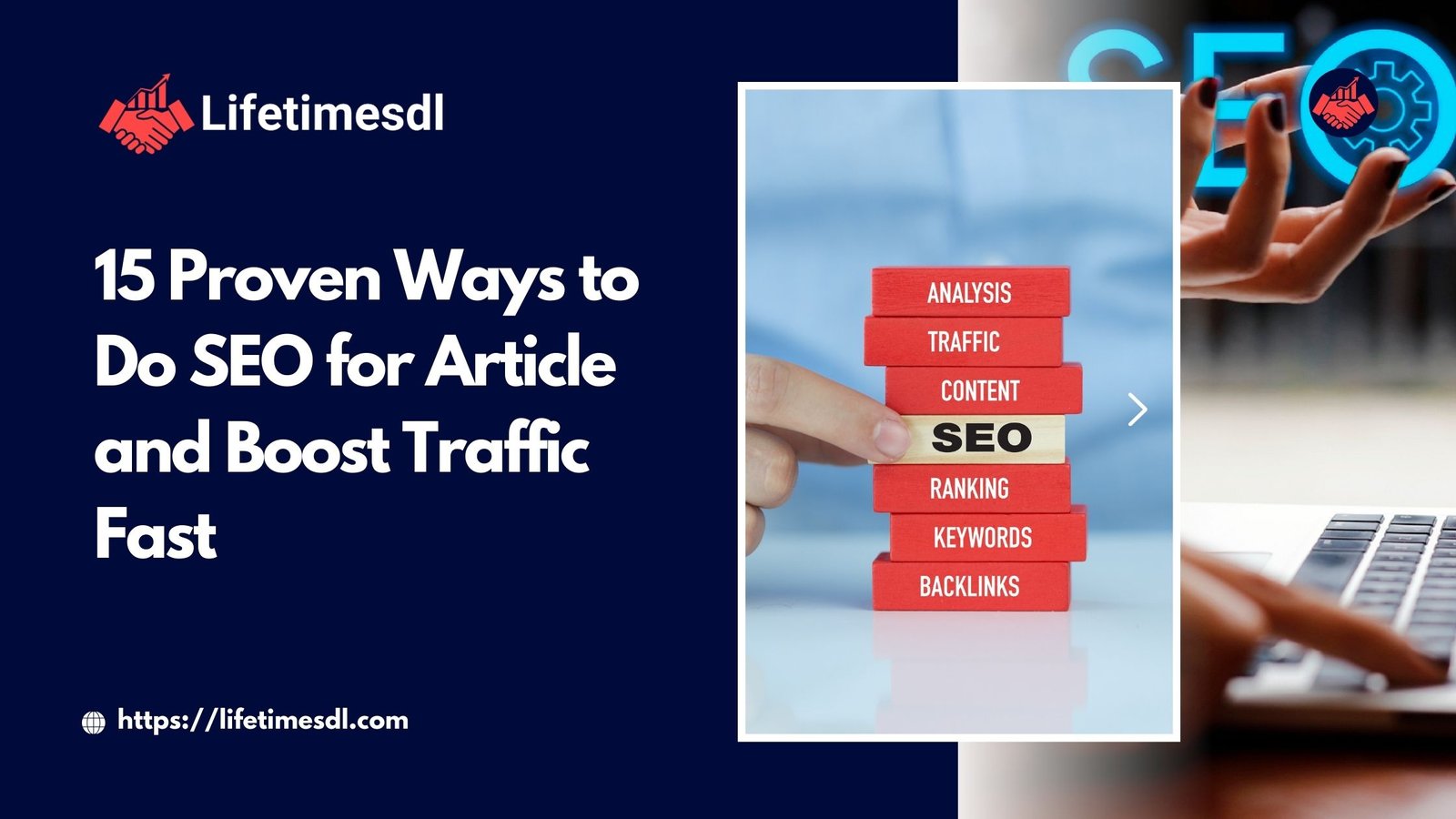To effectively do SEO for article, focus on understanding search intent, using relevant keywords, creating original content, and optimizing technical elements like title tags and backlinks for better search rankings.
In the competitive world of digital marketing, Search Engine Optimization (SEO) remains one of the most powerful tools to increase website traffic and rankings. If you’re wondering how to do SEO for article, then you’re in the right place. This article covers proven SEO tips that will help your articles gain visibility, engage readers, and rank higher on search engines like Google. We will explore various strategies, from understanding search intent to optimizing your content for the best user experience. By following these SEO practices, you’ll boost traffic, improve rankings, and drive organic growth for your website.
1. Understanding Search Intent

Before diving into any article optimization, it’s crucial to understand search intent. This refers to the reason behind a user’s search query and dictates the kind of content they are seeking. Ignoring search intent is one of the most common SEO mistakes, but it can drastically affect your article’s ranking.
- Informational intent: Users are looking for information on a topic.
- Navigational intent: Users want to find a specific website or page.
- Transactional intent: Users are in the process of making a purchase or taking action.
To effectively target search intent, study the top results in search engines for your target keyword. Analyze the types of content that rank well and tailor your article to match that intent. By aligning with search intent, your article becomes more relevant, improving its chances of ranking higher.
2. The Power of Keyword Research

Keyword research forms the foundation of any SEO strategy. When you’re wondering how to do SEO for article, the first thing you must do is identify high-performing keywords. Keywords are phrases that users enter into search engines, and by strategically incorporating them into your article, you can improve your rankings.
To start, use tools like Google Keyword Planner, SEMrush, or Ahrefs to find relevant keywords. When doing keyword research, focus on:
- Long-tail keywords (specific, less competitive phrases)
- Keyword relevance to your topic
- Search volume to gauge interest in the topic
Make sure your target keyword appears in the title tag, within the first 100 words of the article, and naturally throughout the body text. But be cautious not to overstuff your content with keywords as this can lead to penalties.
3. Crafting High-Quality, Original Content
Creating high-quality, original content is essential for SEO. Content that is well-written, relevant, and engaging has a higher chance of ranking better on Google. The key here is not to write content solely for search engines but for human readers.
- Offer value by answering questions.
- Use original research and insights.
- Keep content fresh and updated regularly.
When you produce unique, high-value content, it helps build authority in your niche. For example, you can create in-depth guides, how-to articles, or case studies that provide thorough answers to your audience’s questions. This not only improves your E-E-A-T (Experience, Expertise, Authoritativeness, and Trustworthiness) but also helps your article stand out in the SERPs.
4. Optimizing Title Tags and Meta Descriptions
The title tag and meta description are two crucial elements that impact your SEO rankings. These elements not only influence your ranking but also your click-through rate (CTR), as they are the first thing users see in the search results.
- Title tags should include the target keyword, be between 50-60 characters, and be engaging.
- Meta descriptions should summarize the content of the article, be between 150-160 characters, and feature the target keyword.
Make both elements compelling and relevant. A good title will convince users to click on your article over others. Similarly, a strong meta description acts as a mini-advertisement for your article.
5. Creating Short, Descriptive URLs
One of the easiest yet highly effective SEO tips is creating short, descriptive URLs. A well-crafted URL not only helps search engines understand the content but also enhances user experience.
For instance, instead of using a long, random URL like: https://example.com/blog/2021/08/15/how-to-do-seo-for-article
Use something simpler and more SEO-friendly: https://example.com/blog/how-to-do-seo-for-article
Make sure to include the main keyword in the URL for better SEO, and avoid unnecessary numbers or special characters. Short URLs are easier to share and remember, improving the chances of your content going viral.
6. Building High-Quality Backlinks

Backlinks are links from other websites that point to your content. They act as votes of confidence, signaling to search engines that your content is valuable and authoritative.
- Guest posts on reputable websites.
- Link outreach to influencers or industry experts.
- Create shareable content like infographics or videos.
Remember that quality matters more than quantity. A few backlinks from authoritative sites will have a greater impact than many backlinks from low-quality sources.
7. Leveraging Internal and External Links
Linking internally within your own website is another effective strategy. Internal links help search engines crawl your site and discover related content. They also help improve the user experience by guiding visitors to other relevant pages.
Similarly, external links (links to other trusted websites) help build credibility. By referencing authoritative sources, you not only enhance your content’s reliability but also improve the chances of your article ranking higher.
8. Improving Core Web Vitals
Core Web Vitals measure the user experience of your website, focusing on page load speed, interactivity, and stability. Google uses these metrics as ranking factors, so optimizing them is crucial.
- Improve page load times by compressing images and reducing server response time.
- Ensure mobile-friendliness to cater to users on smartphones.
- Focus on eliminating layout shifts that affect user experience.
By enhancing Core Web Vitals, you improve both the SEO performance of your article and the overall user experience.
9. Optimizing Visual Assets
Images and other visual assets not only enhance your content but also help SEO when properly optimized. Large images can slow down your page, negatively impacting your rankings. Here’s how to optimize them:
- Compress images to reduce file size.
- Use descriptive file names and alt text for accessibility and SEO.
- Choose the correct format for each type of image (JPEG, PNG, etc.).
Optimized images lead to faster page loading times, which can improve your rankings.
10. Analyzing Organic Search Competitors
Analyzing your organic search competitors helps you understand what’s working for them and how you can improve your own strategy. Identify the pages that rank high for your target keywords and assess:
- The quality of their content.
- The number of backlinks they have.
- The structure and usability of their site.
Once you know what your competitors are doing right, aim to do it better. Offer more value, create more engaging content, and build better backlinks.
11. Website Architecture and Navigation
A well-structured website not only helps search engines crawl your pages but also makes it easier for users to navigate your content. Organize your content into categories and use clear navigation to help both users and search engines understand your website’s hierarchy.
A clear structure improves your site’s SEO by allowing search engines to index your pages faster.
12. Call-to-Actions (CTAs) for Engagement
Effective CTAs (call-to-actions) guide your users toward a desired action. Whether you want users to subscribe to a newsletter or purchase a product, CTAs are vital for driving engagement.
Make sure your CTAs are visible, engaging, and relevant to the content on your page.
13. Building Topic Clusters
Topic clusters are groups of related content that help establish your site as an authority on a specific subject. When you build topic clusters, you can link articles together, improving the overall SEO performance of your website.
Create a pillar page that covers a broad topic and link to related cluster content. This strategy boosts rankings and helps build your site’s authority.
14. Utilizing FAQs for SEO Success
Adding an FAQ section to your articles can help you rank for Google’s People Also Ask boxes. By answering common questions concisely, you can improve the likelihood of appearing in a featured snippet.
FAQs also allow you to target long-tail keywords and improve user experience by addressing common concerns.
15. E-E-A-T: Expertise, Authoritativeness, and Trustworthiness
Google’s E-E-A-T guidelines focus on evaluating the quality of your content based on the experience, expertise, authority, and trustworthiness of the author or site.
- Show expertise by offering in-depth, well-researched content.
- Build authority through backlinks from reputable sources.
- Establish trust by including clear information about the author and offering verifiable facts.
Focusing on E-E-A-T helps you build credibility, which is vital for improving SEO performance.
Conclusion
SEO is a powerful tool that, when executed correctly, can drive organic traffic and improve your website’s rankings. By following these steps and optimizing your article for both search engines and readers, you’ll be on the path to SEO success. Focus on understanding search intent, conducting thorough keyword research, creating high-quality content, and applying technical SEO elements to ensure your articles stand out. Keep optimizing, stay updated with SEO trends, and watch your traffic grow.

